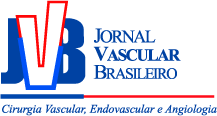Effects of walking and strength training on walking capacity in individuals with claudication: meta-analysis
Efeitos do treinamento de caminhada e forca na capacidade de caminhada de claudicantes: meta-analise
Alessandra de Souza Miranda; Lausanne Barreto de Carvalho Cahu Rodrigues; Sergio Luiz Cahu Rodrigues; Crivaldo Gomes Cardoso Junior; Maryela Oliveira Menacho; Diego Giulliano Destro Christofaro; Raphael Mendes Ritti-Dias
Abstract
Keywords
Resumo
Palavras-chave
References
Wang J, Zhou S, Bronks R, Graham J, Myers S. Effects of supervised treadmill-walking training on strength and endurance of the calf muscles of individuals with peripheral arterial disease. Clin J Sport Med.. ;16:397-400.
Dormandy JA, Rutherford RB. Management of peripheral arterial disease (PAD). TASC Working Group. TransAtlantic Inter-Society Consensus (TASC). J Vasc Surg.. ;31:S1-S296.
Criqui MH, Fronek A, Barrett-Connor E, Klauber MR, Gabriel S, Goodman D. The prevalence of peripheral arterial disease in a defined population. Circulation.. ;71:510-15.
Selvin E, Erlinger TP. Prevalence of and risk factors for peripheral arterial disease in the United States: results from the National Health and Nutrition Examination Survey, 1999-2000. Circulation.. ;110:738-43.
Regensteiner JG, Steiner JF, Hiatt WR. Exercise training improves functional status in patients with peripheral arterial disease. J Vasc Surg.. ;23:104-15.
Regensteiner JG, Wolfel EE, Brass EP. Chronic changes in skeletal muscle histology and function in peripheral arterial disease. Circulation.. ;87:413-21.
Gerdle B, Hedberg B, Angquist KA, Fugl-Meyer AR. Isokinetic strength and endurance in peripheral arterial insufficiency with intermittent claudication. Scand J Rehabil Med.. ;18:9-15.
Norgren L, Hiatt WR, Dormandy JA. Inter-society consensus for the management of peripheral arterial disease. Int Angiol.. ;26:81-157.
Hodges LD, Sandercock GR, Das SK, Brodie DA. Randomized controlled trial of supervised exercise to evaluate changes in cardiac function in patients with peripheral atherosclerotic disease. Clin Physiol Funct Imaging.. ;28:32-7.
McGuigan MR, Bronks R, Newton RU. Resistance training in patients with peripheral arterial disease: effects on myosin isoforms, fiber type distribution, and capillary supply to skeletal muscle. J Gerontol A Biol Sci Med Sci.. ;56:B302-B310.
Hirsch AT, Haskal ZJ, Hertzer NR. ACC/AHA 2005 Practice Guidelines for the management of patients with peripheral arterial disease (lower extremity, renal, mesenteric, and abdominal aortic): a collaborative report from the American Association for Vascular Surgery/Society for Vascular Surgery, Society for Cardiovascular Angiography and Interventions, Society for Vascular Medicine and Biology, Society of Interventional Radiology, and the ACC/AHA Task Force on Practice Guidelines (Writing Committee to DevelPMid:16549646.op Guidelines for the Management of Patients With Peripheral Arterial Disease): endorsed by the American Association of Cardiovascular and Pulmonary Rehabilitation; National Heart, Lung, and Blood Institute; Society for Vascular Nursing; TransAtlantic Inter-Society Consensus; and Vascular Disease Foundation. Circulation. ;113:e463-e654.
Alpert JS, Larsen OA, Lassen NA. Exercise and intermittent claudication. Blood flow in the calf muscle during walking studied by the xenon-133 clearance method. Circulation.. ;39:353-59.
Dahllof AG, Bjorntorp P, Holm J, Schersten T. Metabolic activity of skeletal muscle in patients with peripheral arterial insufficiency. Eur J Clin Invest.. ;4:9-15.
Dahllof AG, Holm J, Schersten T, Sivertsson R. Peripheral arterial insufficiency, effect of physical training on walking tolerance, calf blood flow, and blood flow resistance. Scand J Rehabil Med. :8-.
Hiatt WR, Wolfel EE, Meier RH, Regensteiner JG. Superiority of treadmill walking exercise versus strength training for patients with peripheral arterial disease. Implications for the mechanism of the training response. Circulation.. ;90:1866-874.
McDermott MM, Ades P, Guralnik JM. Treadmill exercise and resistance training in patients with peripheral arterial disease with and without intermittent claudication: a randomized controlled trial. JAMA.. ;301:165-74.
Ritti-Dias RM, Wolosker N, De Moraes Forjaz CL. Strength training increases walking tolerance in intermittent claudication patients randomized trial. J Vasc Surg.. ;51:89-95.
Wang E, Helgerud J, Loe H, Indseth K, Kaehler N, Hoff J. Maximal strength training improves walking performance in peripheral arterial disease patients. Scand J Med Sci Sports.. ;20(5):764-70.
Crowther RG, Spinks WL, Leicht AS, Sangla K, Quigley F, Golledge J. Effects of a long-term exercise program on lower limb mobility, physiological responses, walking performance, and physical activity levels in patients with peripheral arterial disease. J Vasc Surg. ;47:303-09.
Mika P, Spodaryk K, Cencora A, Mika A. Red blood cell deformability in patients with claudication after pain-free treadmill training. Clin J Sport Med.. ;16:335-40.
Sanderson B, Askew C, Stewart I, Walker P, Gibbs H, Green S. Short-term effects of cycle and treadmill training on exercise tolerance in peripheral arterial disease. J Vasc Surg.. ;44:119-27.
Tsai JC, Chan P, Wang CH. The effects of exercise training on walking function and perception of health status in elderly patients with peripheral arterial occlusive disease. J Intern Med.. ;252:448-55.
Parr BM, Noakes TD, Derman EW. Peripheral arterial disease and intermittent claudication: efficacy of short-term upper body strength training, dynamic exercise training, and advice to exercise at home. S Afr Med J.. ;99:800-04.
Schlager O, Giurgea A, Schuhfried O. Exercise training increases endothelial progenitor cells and decreases asymmetric dimethylarginine in peripheral arterial disease: a randomized controlled trial. Atherosclerosis.. ;217:240-48.



